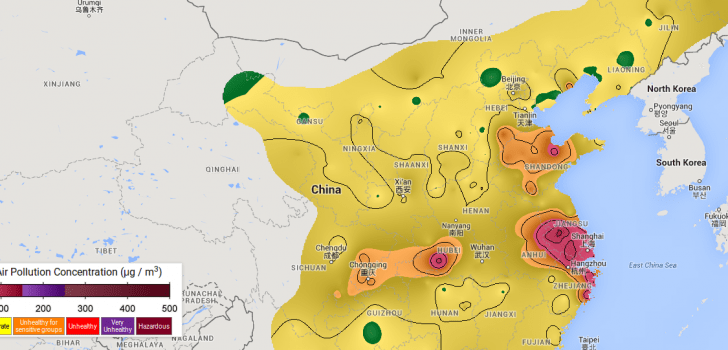Google will now display pollution reports from across China in collaboration with University of California Berkeley scientists using data from 1,500 sites around the nation. The new online map uses results published last month in PLoS One, which is the world’s largest peer reviewed scientific journal, and showed that heavy pollution areas were not limited to the nation’s major cities or low-lying areas.
Current statistics estimate that 1.4 million people in China die each year from air pollution alone and the map makes it easy to see why.
The vast majority of the country lives with health-affecting levels of pollution.
The data showed that over 90 percent of the population experienced at least 120 hours of unhealthy air over a four month period in 2014. The color-coded map is produced based on sub-2.5 micron particulate concentrations, which are considered to be the most damaging to humans.
The new data comes amid recent changes by China to its Air Pollution Control Law, which will aim to cover previously unregulated shipping activities. China is home to eight of the top ten shipping ports in the world, and these areas heavily contribute to the nation’s air pollution problems. The new rules provide for a legal foundation for the government to control shipping emissions, in a first for the country.
Bilateral talks in June between the U.S. and China involved the exchange of industry best practices in the pursuit of cleaner air at shipping ports. The U.S. also invited representatives from Jiangsu’s Environmental Protection Bureau for a fall 2015 showcase of various technologies and practices for air quality control. Other discussions resulted in the promise by China to promote the use of clean cooking stoves in at least 40 million rural households by 2020 as part of the Global Alliance for Clean Cookstoves world goal of 100 million.
New terminals at Chinese ports will allow ships to be powered by shore-side electric power so that their diesel engines are not needed, and all ships will need certification to meet national air emission standards. China will also pursue a policy of controlling high pollution areas using new authority granted to its Ministry of Transport, to enforce stricter regulations on so-called Emissions Control Areas (ECAs). The U.S. only recently adopted a similar policy as a result of a 2009 agreement.
Stay Connected